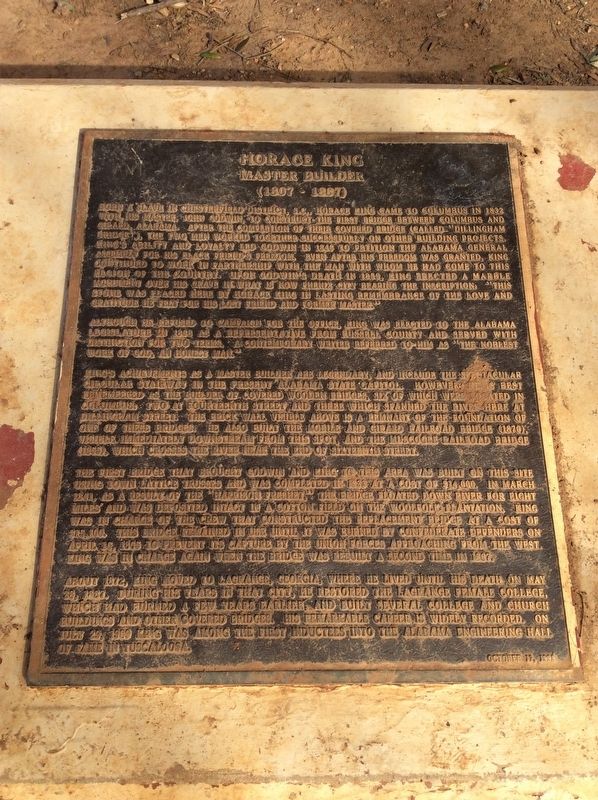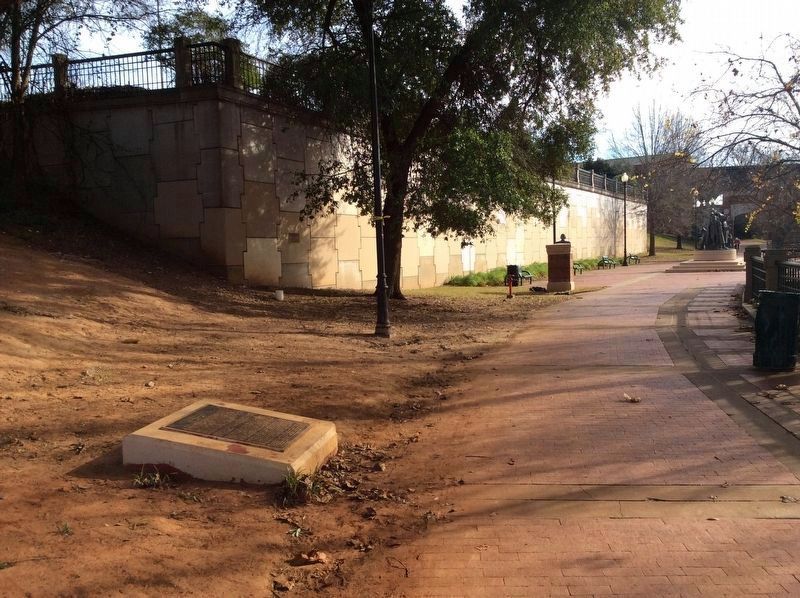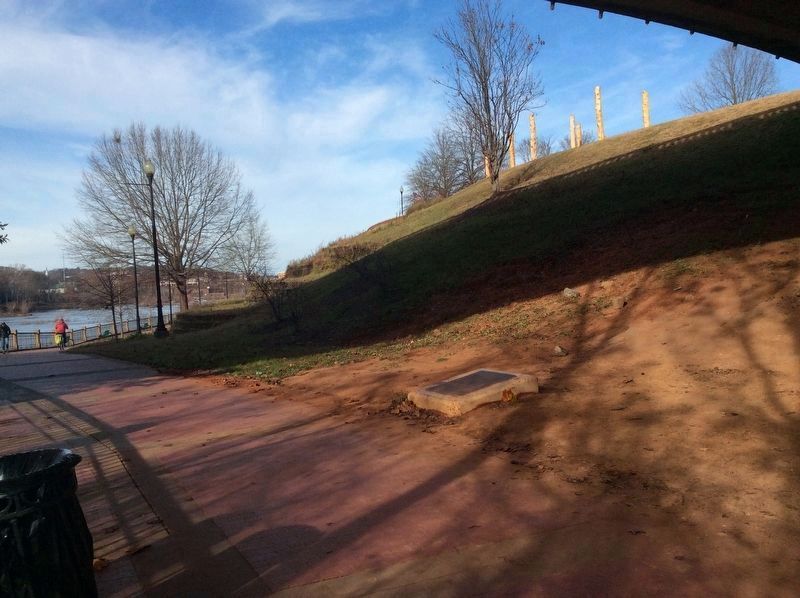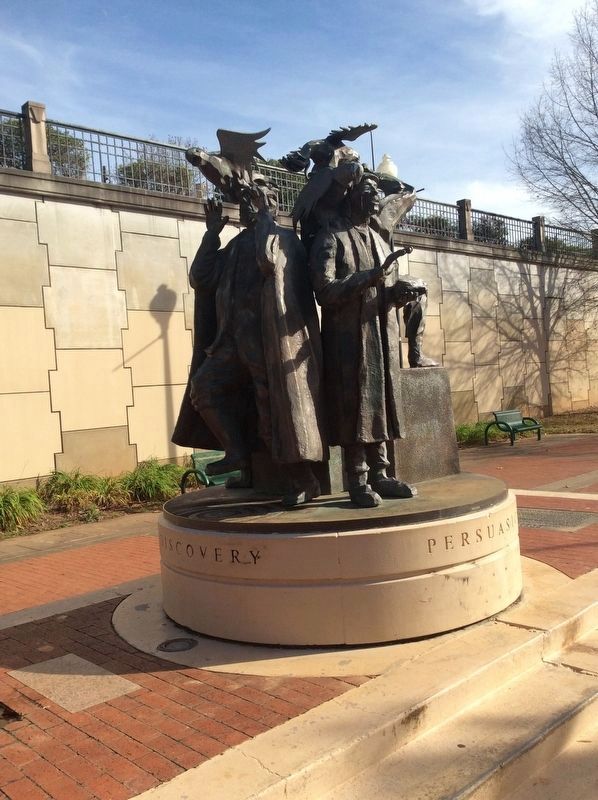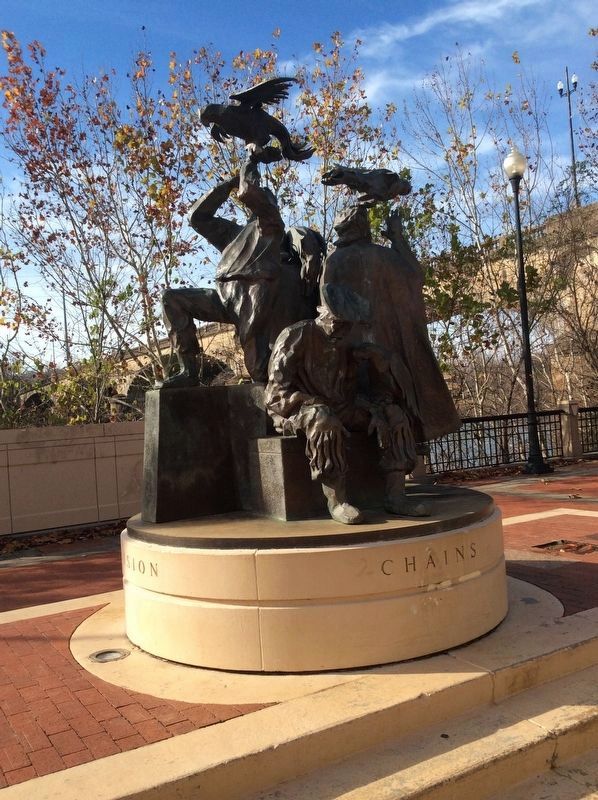Columbus in Muscogee County, Georgia — The American South (South Atlantic)
Horace King
Master Builder
Master Builder
(1807-1887)
Although he refused to campaign for the office, King was elected to the Alabama Legislature in 1868 as a representative from Russell County and served with distinction for two terms. A contemporary writer referred to him as “the noblest work of God, an honest man.”
King’s achievements as a master builder are legendary, and include the spectacular circular stairway in the present Alabama State Capitol. However, he is best remembered as the builder of covered wooden bridges, six of which were located in Columbus: two at Fourteenth Street and three which spanned the river here at Dillingham Street. The brick wall visible above is a remnant of the foundation of one of these bridges. He also built the Mobile and Girard Railroad Bridge (1870), visible immediately downstream from this spot, and the Muscogee Railroad Bridge (1855), which crosses the river near the end of Sixteenth Street.
The first bridge that brought Godwin and King to this area was built on this site using Town Lattice trusses and was completed in 1833 at a cost of $14,000. In March 1841, as a result of the “Harrison Freshet,” the bridge floated down river for eight miles and was deposited intact in a cotton field on the Woolfolk Plantation. King was in charge of the crew that constructed the replacement bridge at a cost of $15,100. This bridge remained in use until it was burned by Confederate defenders on April 16, 1865 to prevent its capture by the Union forces approaching from the west. King was in charge again when the bridge was rebuilt a second time in 1867.
About 1872, King moved to LaGrange, Georgia, where he lived until his death on May 28, 1887. During his years in that city, he restored the LaGrange Female College, which had burned a few years earlier,
and rebuilt several college and church buildings and other covered bridges. His remarkable career is widely recorded. On July 29, 1989 King was among the first inductees into the Alabama Engineering Hall of Fame in Tuscaloosa.
October 11, 1993
Erected 1993.
Topics and series. This historical marker is listed in these topic lists: African Americans • Bridges & Viaducts • Industry & Commerce. In addition, it is included in the Covered Bridges series list. A significant historical month for this entry is March 1841.
Location. 32° 27.812′ N, 84° 59.818′ W. Marker is in Columbus, Georgia, in Muscogee County. Marker is on Chattahoochee Riverwalk, on the left when traveling south. The marker is along the Chattahoochee Riverwalk directly under the modern Dillingham Bridge in Columbus, Georgia. Touch for map. Marker is in this post office area: Columbus GA 31901, United States of America. Touch for directions.
Other nearby markers. At least 8 other markers are within walking distance of this marker. Columbus Steamboat Wharf (within shouting distance of this marker); Military Service Walk (about 300 feet away, measured in a direct line); River Commerce (about 500 feet away); Columbus Iron Works (about 500 feet away); The Chattahoochee River (about 500 feet away); Confederates Set Fire To Lower Bridge (about
700 feet away in Alabama); POW ✯ MIA Monument (about 800 feet away in Alabama); Coweta and Northeastern Russell County: (about 800 feet away in Alabama). Touch for a list and map of all markers in Columbus.
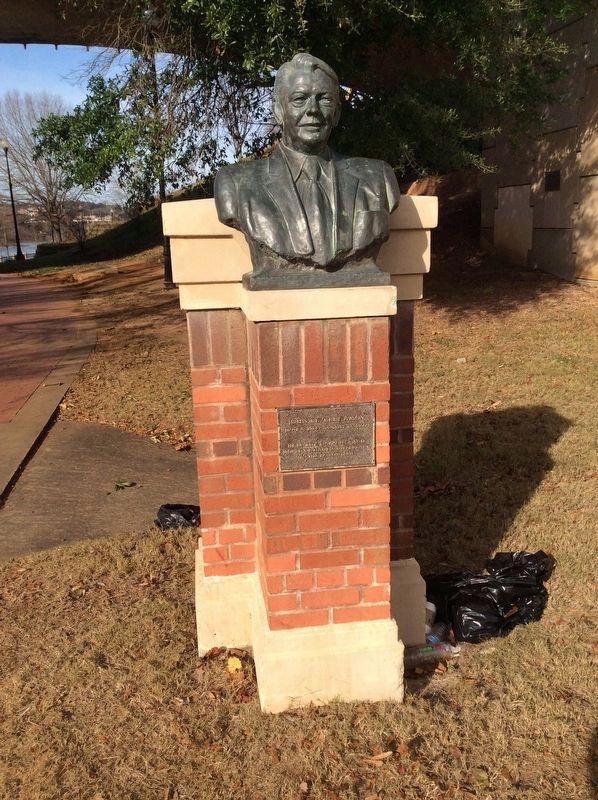
Photographed By J. Makali Bruton, December 25, 2017
4. Bust of John Amos, co-founder of AFLAC (American Family Life Assurance Company)
The Horace King marker can be seen in the distance on the left. The small marker on this monument reads:
John Beverly Amos
June 2, 1924 – August 13, 1990
He lived a happy life and hoped he made a difference to his fellowman
June 2, 1924 – August 13, 1990
He lived a happy life and hoped he made a difference to his fellowman
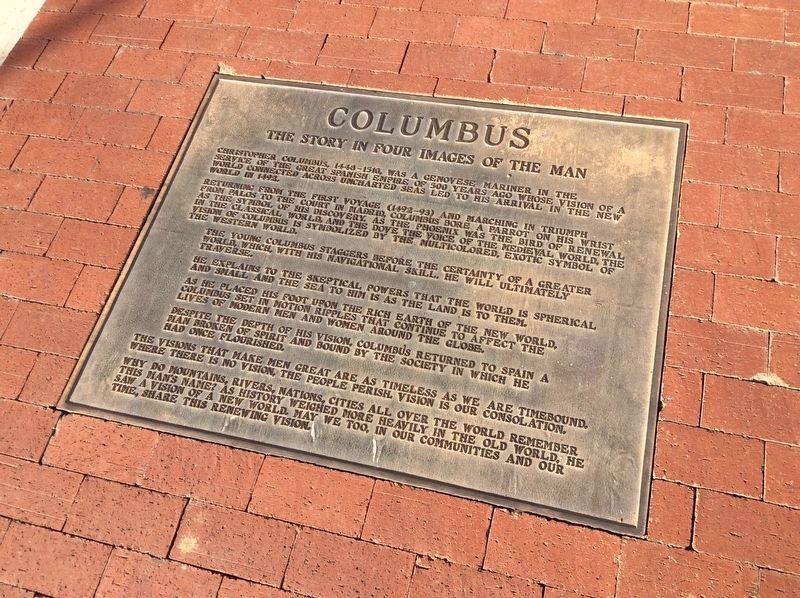
Photographed By J. Makali Bruton, December 25, 2017
5. Columbus Marker
A few steps south of the Horace King marker is this additional marker, near a statue representing the life of Christopher Columbus. It reads:
Columbus
The Story in Four Images of the Man
Christopher Columbus, 1448-1510, was a Genovese mariner in the
service of the great Spanish Empire of 500 years ago whose vision of a
world connected across uncharted seas led to his arrival in the new
world in 1492. Returning from the first voyage (1492-93) and marching in triumph from Palos to the court in Madrid, Columbus bore a parrot on his wrist as the symbol of his discovery, as the phoenix was the bird of renewal in the classical world, and the dove the voice of the medieval world, the vision of Columbus is symbolized by the multicolored, exotic symbol of the western world. The young Columbus staggers before the certainty of a greater world, which, with his navigational skill, he will ultimately traverse. He explains to the skeptical powers that the world is spherical and small and the sea to him is as the land is to them. As he placed his foot upon the rich earth of the new world, Columbus set in motion ripples that continue to affect the lives of modern men and women around the globe. Despite the depth of his vision, Columbus returned to Spain a man broken of spirit and bound by the society in which he had once flourished. The visions that make men great are as timeless as we are timebound, where there is no vision, the people perish. Vision is our consolation. Why do mountains, rivers, nations, cities all over the world remember this man's name? As history weighed more heavily in the old world, he saw a vision of a new world, may we too, in our communities and our time, share this renewing vision.
The Story in Four Images of the Man
Credits. This page was last revised on February 25, 2018. It was originally submitted on February 8, 2018, by J. Makali Bruton of Accra, Ghana. This page has been viewed 498 times since then and 43 times this year. Last updated on February 10, 2018, by Byron Hooks of Sandy Springs, Georgia. Photos: 1, 2, 3. submitted on February 8, 2018, by J. Makali Bruton of Accra, Ghana. 4, 5, 6, 7. submitted on February 9, 2018, by J. Makali Bruton of Accra, Ghana.
